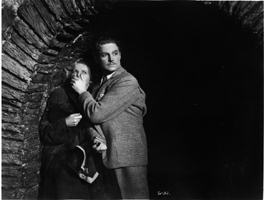

UK film school
1935
bw 87 min.
Director: Alfred Hitchcock
CLV: $29.95 - available
1 disc, catalog # CC1103L
VHS: available from Home Vision Cinema

Movie
thrillers may come and go, but after half a century, Alfred
Hitchcock's The 39 Steps still reigns supreme. And not only for
the sheer, breathless excitement of the story; the seamless
construction; the chilling, beautifully realized atmosphere; and the
constant, startling stream of plot twists. Nor for its historical
importance, though almost every chase and spy thriller since 1935
copies it slavishly. Nor for its actors -- despite a truly excellent
ensemble: Madeleine Carroll as Pamela, the cool Hitchcockian blond;
Lucie Mannheim as a seductive lady of mystery; Godfrey Tearle as an
urbane master criminal; Peggy Ashcroft and John Laurie as a moody
farming couple on the barren Scottish moors; Wylie Watson as that
Proustian prodigy, Mr. Memory -- and, at the center, Robert Donat as
the endlessly suave and resilient Richard Hannay, a fugitive who keeps
his quiet wit and brilliant resources, no matter what dangerous curve
Fate (and Hitchcock) manage to throw him.More than anything else,
the film keeps its preeminent place because this is the movie in which
Hitchcock became "Hitchcock" -- and for which he earned the reputation
which he never relinquished as "The Master of Suspense." Hitchcock had
major successes before, but The 39 Steps was the first with
major international impact. No previous Hitchcock so gripped, amused
or thrilled audiences from Europe to America, Australia to Asia. More
than any of his previous 19 British films, or the five which followed,
it is the movie which was responsible for his emigration to America,
as a first-rank filmmaker. In fact, for many years, most critics
insisted that Hitchcock had never equaled or surpassed The 39
Steps. Well into the 1960s, it was still commonly called his best
movie. André Bazin: "It remains indubitably his masterpiece and
a model for detective comedies." Pauline Kael: "This suave, amusing
spy melodrama is . . . charged with wit; it's one of the three or four
best things Hitchcock ever did."
The Hitchcock of 1935 was a
director of a decade's experience, the master of his craft, adapting a
novel by one of his favorite authors, John Buchan. And Hitchcock was
telling a story of strong personal appeal -- so strong that he used
bits and pieces of it throughout his career. In Young and
Innocent (1937), Foreign Correspondent (1940),
Saboteur (1942), To Catch a Thief (1955), North by
Northwest (1959), Torn Curtain (1966) and Frenzy
(1972), we get part, or most, of the basic situation here: the "wrong
man," wrongly accused of a crime he did not commit, fleeing through
dangerous or colorful locales -- sometimes engaged in erotic sparring
with a woman both desirous and fearful of him, trying desperately to
find the evil doppelganger who has committed the sins which cling to
him.
In discussing the film with Truffaut, Hitchcock said: "What I
like best about The 39 Steps are the swift transitions." And
it's that swift, unremitting pace, those lightning transitions, that
keep it fresh, bewitching. The editing is so ingenious that some
examples have become textbook legends: the landlady's scream, on
discovering a corpse, which, before we hear it, becomes the shriek of
the train whistle as Hannay escapes. We race at breakneck speed, from
the seedy London streets and the Palladium Music Hall, through the
forbidding Scottish moors under eternal, glowering skies, and back to
London, where another Palladium performance squares the circle.
But
the swift transitions are more than geographic or physical. Hitchcock,
as he would many times again, offers a dizzying set of moral
alterations: a world where love and death, fear and desire are in
constant, nerve-wracking, and sometimes acidly humorous
juxtaposition. Hannay begins his perilous odyssey with what seems an
innocuous peccadillo: meeting and taking home a woman who calls
herself "Mrs. Smith." Romance leads to danger: the woman is not a
pickup; she is a hunted spy, fearful for her life. Hannay escapes from
his London flat by pretending to a milkman that he is a lady-killer,
ducking a vengeful husband -- something he very nearly becomes later,
on the moors, when a dour farmer mistakes his desperation for
lust. Later he tries to escape the police by passionately embracing a
total stranger (to her fury); while still later, he winds up manacled
to that same stranger, taking refuge at an inn where the beaming
landlady, impressed at their constant togetherness, exclaims: "They're
so terribly in love with each other!" Love and death, sex and
slaughter -- these are the poles of the universe so playfully
presented here: supplanting each other, reversing and replacing each
other, becoming a shadowy, deeply disturbing double mirror.
The
39 Steps is that rarity: a bona fide cinematic masterpiece which
the public clasps to its bosom, a great work which is also a great
crowd-pleaser: amusing and scary, engaging and engrossing, full of
dazzling light and eerie shadow. Hitchcock liked to remark, with what
may have been a sly touch of self-deprecation: "Most films are slices
of life. Mine are slices of cake." This particular cake is one of his
most luscious: dark, savory, a richly compulsive treat. -- MICHAEL
WILMINGTON
CREDITS
Director: Alfred
Hitchcock
Producers: Michael Balcon, Ivor Montagu
Screenplay:
Charles Bennett, Ian Hay, Alma Reville
Original Story: John
Buchan
Cinematography: Bernard Knowles
Music: Louis
Levy
TRANSFER
This edition of The 39 Steps was
made from the best quality surviving 35mm fine grain print material
known to exist.





